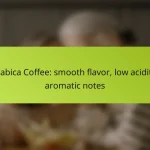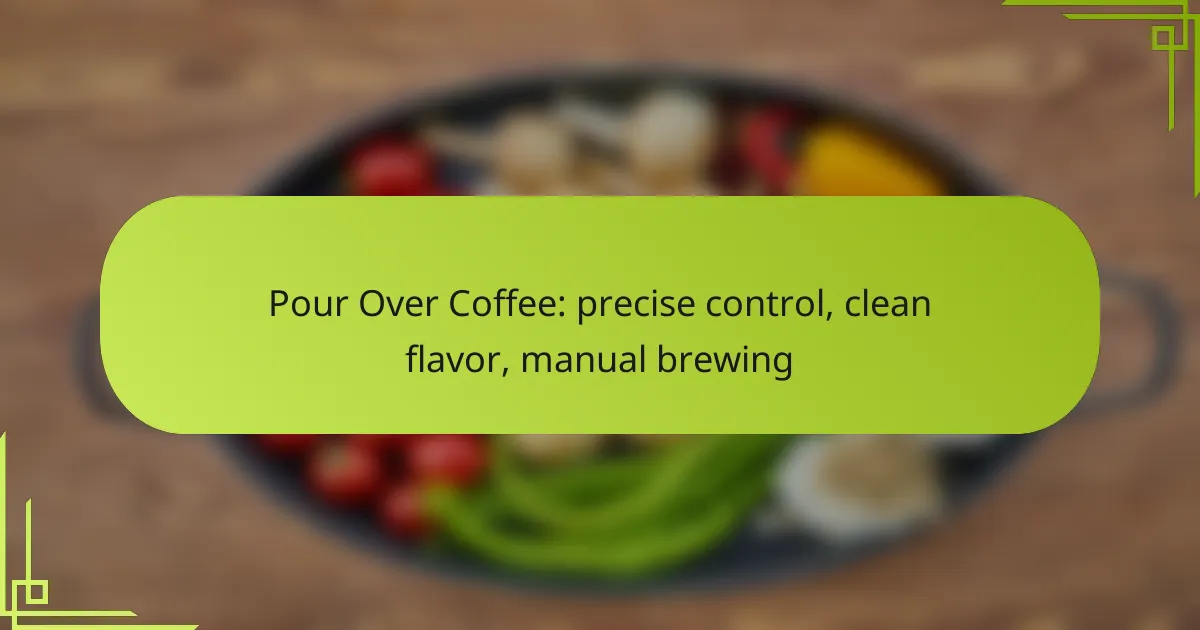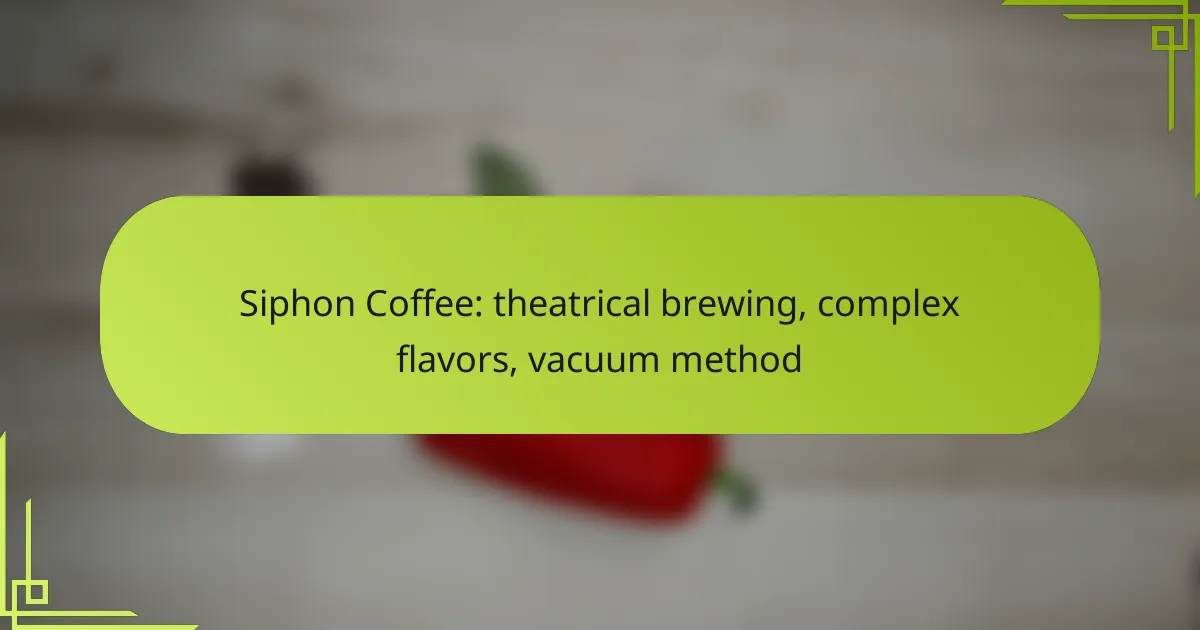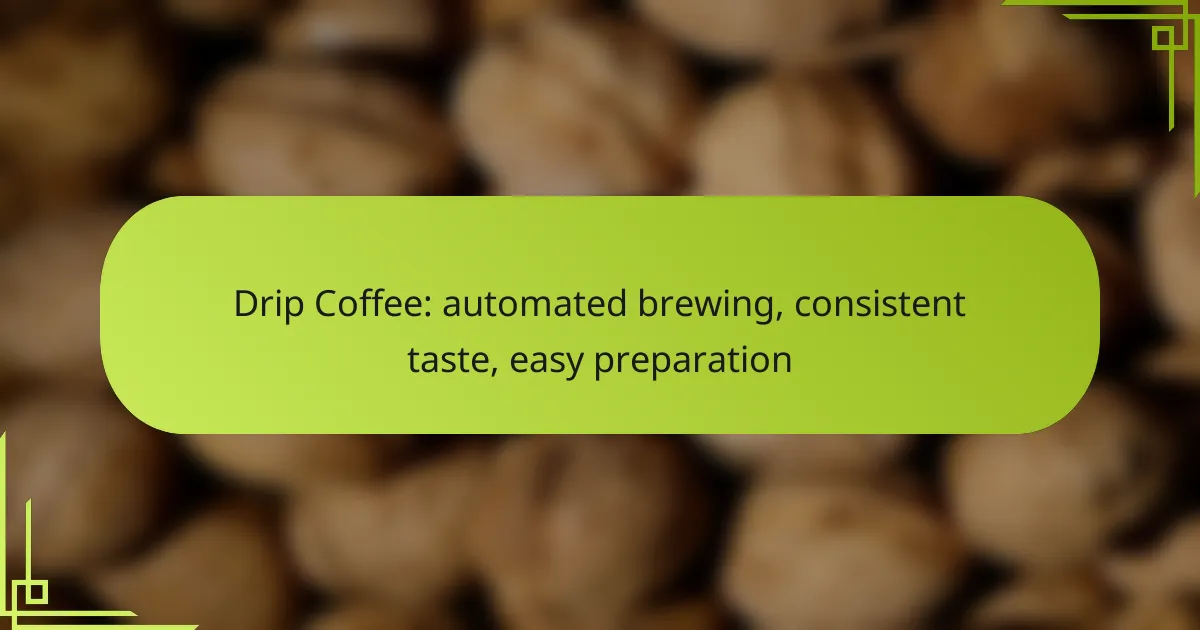Pour over coffee is a manual brewing method that emphasizes precise control over water flow, grind size, and temperature to achieve optimal flavor. This technique allows coffee enthusiasts to extract a clean and vibrant cup, making it a popular choice among those seeking a more hands-on approach to brewing. With the right equipment and freshly roasted beans, pour over coffee can elevate your daily ritual into a flavorful experience.
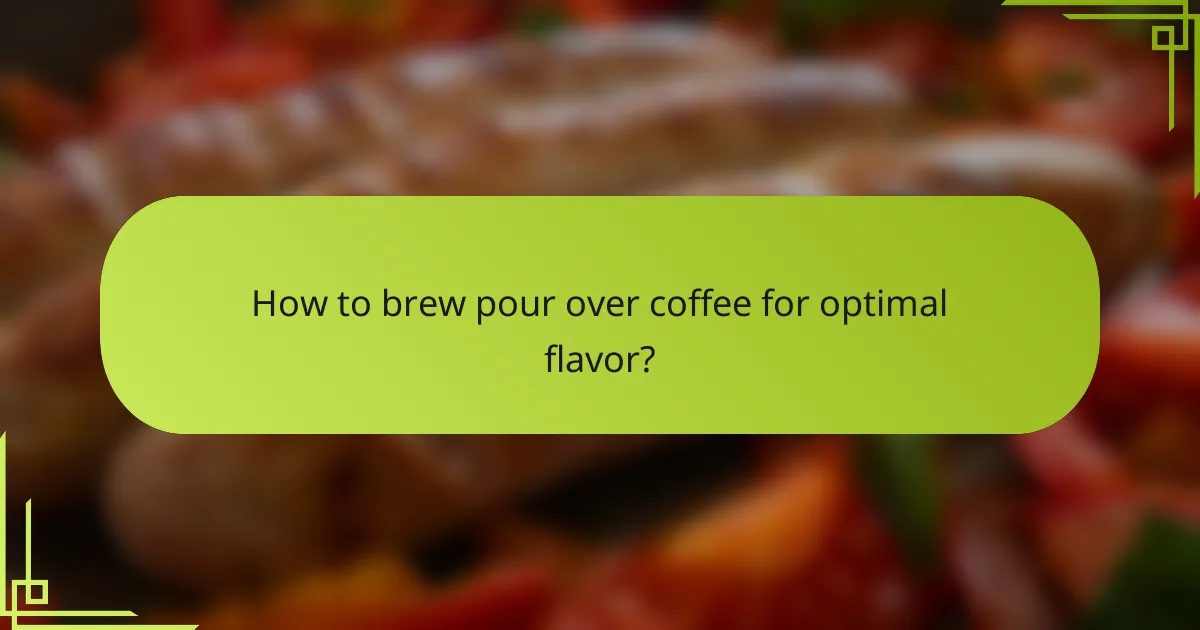
How to brew pour over coffee for optimal flavor?
To brew pour over coffee for optimal flavor, focus on precise control over water flow, grind size, and temperature. These factors significantly influence the extraction process, resulting in a clean and flavorful cup.
Use a gooseneck kettle
A gooseneck kettle allows for better control over the pouring rate and direction, which is crucial for even saturation of the coffee grounds. This precision helps to extract flavors uniformly, preventing over-extraction or under-extraction.
When choosing a gooseneck kettle, consider one with a built-in thermometer for monitoring water temperature. Electric kettles with temperature settings can also streamline the brewing process.
Choose the right coffee grind size
The grind size of your coffee beans plays a pivotal role in flavor extraction during the brewing process. For pour over, a medium-fine grind is often recommended, similar to granulated sugar.
Experimenting with grind size can help you find the perfect balance for your taste. A finer grind may lead to over-extraction and bitterness, while a coarser grind can result in a weak flavor.
Control water temperature
Water temperature should ideally be between 195°F and 205°F (90°C to 96°C) for optimal extraction. Water that is too hot can scorch the coffee, while water that is too cool may not extract enough flavor.
Using a thermometer or an electric kettle with temperature control can help maintain the right heat. Allowing the kettle to cool slightly after boiling can also achieve the desired temperature range.
Follow a precise pouring technique
Pouring technique is essential for achieving an even extraction. Start by pouring a small amount of water to bloom the coffee, allowing gases to escape, then continue pouring in a slow, circular motion.
A good rule of thumb is to pour for about 30 seconds for the bloom and then continue pouring until you reach your desired brew ratio, typically around 1:15 to 1:17 coffee to water. Avoid pouring directly onto the filter to prevent clogging.
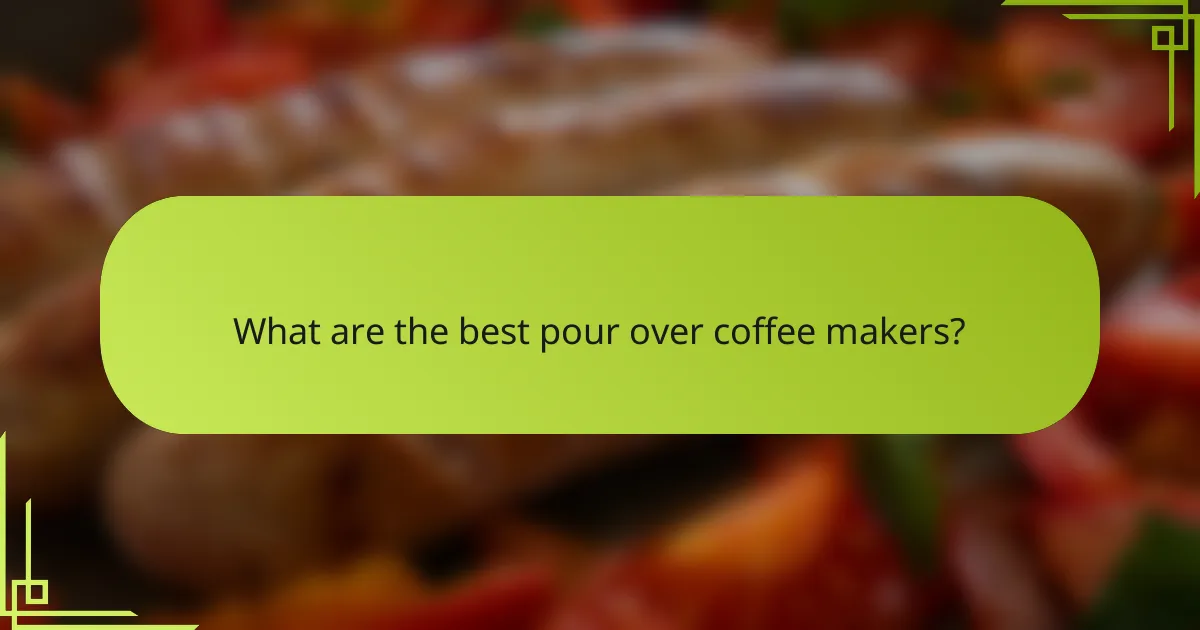
What are the best pour over coffee makers?
The best pour over coffee makers provide precise control over brewing, allowing for a clean and flavorful cup of coffee. Popular choices include the Hario V60, Chemex Classic, and Kalita Wave, each offering unique features and brewing styles.
Hario V60
The Hario V60 is renowned for its conical shape and spiral ridges, which facilitate optimal water flow during brewing. This design allows for a more controlled extraction, making it ideal for coffee enthusiasts who enjoy experimenting with grind size and pouring techniques.
When using the Hario V60, consider using a medium-fine grind and pouring water in a slow, circular motion. This method helps to evenly saturate the coffee grounds, enhancing flavor extraction. Avoid pouring too quickly, as this can lead to uneven brewing and a less desirable taste.
Chemex Classic
The Chemex Classic stands out for its elegant design and thick paper filters, which produce a clean and crisp cup of coffee. The filters remove most oils and sediment, resulting in a lighter flavor profile that many coffee drinkers appreciate.
To brew with a Chemex, use a coarser grind and pour water in a steady, controlled manner. The thicker filters require a longer brewing time, typically around four to five minutes. Be mindful of the water temperature; aim for just off boiling to avoid scalding the coffee.
Kalita Wave
The Kalita Wave features a flat-bottom design with three small holes, promoting even extraction and reducing the risk of channeling. This design is particularly forgiving for beginners, making it easier to achieve consistent results.
For optimal brewing with the Kalita Wave, use a medium grind and pour water in a gentle, circular motion. The brewing time usually ranges from three to four minutes. Pay attention to the water-to-coffee ratio; a common guideline is to use about 1:15 for a balanced cup.

What coffee beans are ideal for pour over brewing?
For pour over brewing, the ideal coffee beans are typically single-origin, medium roast, and freshly roasted. These characteristics enhance the control over flavor extraction and contribute to a clean, vibrant cup of coffee.
Single-origin beans
Single-origin beans come from a specific region, farm, or producer, allowing for unique flavor profiles that reflect their origin. This specificity can enhance the tasting experience, as each region imparts distinct notes, such as fruity, floral, or nutty flavors.
When selecting single-origin beans for pour over, consider trying beans from regions like Ethiopia or Colombia, known for their bright acidity and complex flavors. Experimenting with different origins can help you discover your preferred taste profile.
Medium roast coffee
Medium roast coffee strikes a balance between acidity and body, making it suitable for pour over brewing. This roast level allows for the development of rich flavors while maintaining some of the bean’s natural characteristics.
Avoid light roasts, which can be overly acidic, or dark roasts, which may mask the subtle flavors. Look for beans labeled as medium roast to ensure a well-rounded cup that highlights the nuances of the coffee.
Freshly roasted coffee
Freshly roasted coffee is crucial for achieving optimal flavor in pour over brewing. Beans are best used within a few weeks of roasting, as they begin to lose their freshness and flavor over time.
To ensure you’re using fresh coffee, buy from local roasters or specialty shops that roast in small batches. Always check the roast date on the packaging, and aim to use the beans within two to four weeks for the best results.
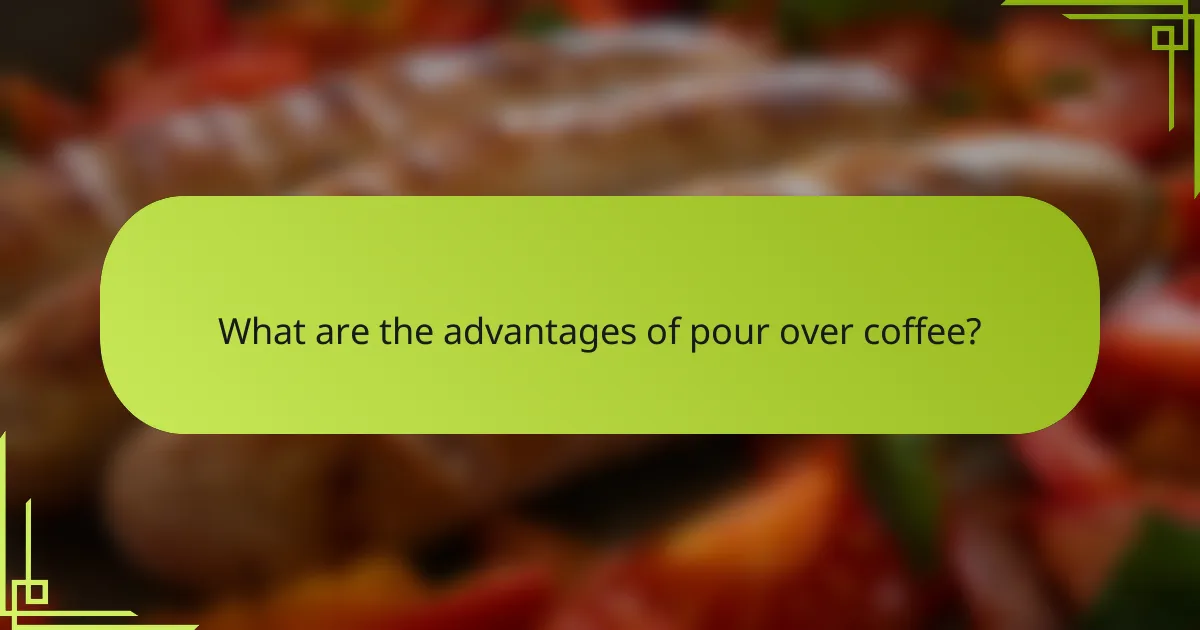
What are the advantages of pour over coffee?
Pour over coffee offers precise control over brewing variables, resulting in a clean and flavorful cup. This manual brewing method allows coffee enthusiasts to tailor their experience to their taste preferences, making it a popular choice among connoisseurs.
Enhanced flavor clarity
Pour over coffee is renowned for its ability to highlight the distinct flavors of different coffee beans. The method allows for a more even extraction, which can bring out nuanced notes that might be muted in other brewing techniques. This clarity is particularly appreciated when using high-quality, single-origin coffees.
By controlling the water temperature and flow rate, you can influence how flavors develop during brewing. Experimenting with these variables can lead to discovering new taste profiles in your favorite beans.
Customizable brewing process
The pour over method is highly customizable, allowing you to adjust factors such as grind size, water temperature, and brew time. For example, a coarser grind and a longer brew time can yield a different flavor profile than a finer grind with a shorter brew time. This flexibility enables you to create a cup that perfectly suits your palate.
Consider using a scale to measure coffee and water accurately, aiming for a common ratio of about 1:15 to 1:17. This precision can help you achieve consistent results and refine your brewing technique over time.
Minimal equipment needed
Pour over coffee requires minimal equipment, making it accessible for home brewers. At its core, you need a pour over dripper, a filter, and a kettle. Many enthusiasts appreciate the simplicity of this setup, which can easily fit into any kitchen.
While you can invest in more advanced tools like a gooseneck kettle or a digital scale, they are not strictly necessary. Starting with basic equipment allows you to focus on mastering the brewing technique before expanding your setup.

How does pour over coffee compare to other brewing methods?
Pour over coffee offers a distinct brewing experience that emphasizes precise control and a clean flavor profile, setting it apart from methods like French press, drip coffee, and espresso. Each brewing technique has its unique characteristics, strengths, and weaknesses, which can significantly affect the taste and quality of the final cup.
Pour over vs French press
Pour over coffee and French press both allow for manual brewing, but they differ in extraction methods. Pour over uses gravity to extract flavors from coffee grounds, resulting in a cleaner cup with less sediment. In contrast, French press immerses coffee grounds in water, leading to a fuller body but often a more robust and heavier texture.
When brewing with a French press, the coffee typically steeps for several minutes, while pour over requires a more precise timing of water flow, usually taking around 2-4 minutes. This difference in brewing time and technique can significantly influence the flavor profile and clarity of the coffee.
Pour over vs drip coffee
Pour over coffee and drip coffee share similarities, as both rely on gravity to brew. However, pour over allows for greater control over variables like water temperature and flow rate, which can enhance flavor extraction. Drip coffee machines automate the process, often leading to less consistency in the final product.
In terms of flavor, pour over typically produces a brighter and more nuanced cup, while drip coffee may result in a more muted taste due to the brewing machine’s limitations. For those who appreciate the intricacies of coffee, pour over is often preferred for its ability to highlight specific flavor notes.
Pour over vs espresso
Pour over and espresso represent two very different approaches to coffee brewing. Espresso is made by forcing hot water through finely-ground coffee under high pressure, resulting in a concentrated shot with a rich crema. Pour over, on the other hand, involves a slower extraction process that yields a lighter, more delicate flavor profile.
Espresso typically requires specialized equipment and finely ground coffee, while pour over can be done with basic tools like a dripper and filter. The choice between the two often comes down to personal preference, as espresso offers intensity and richness, whereas pour over emphasizes clarity and subtlety in flavor.
